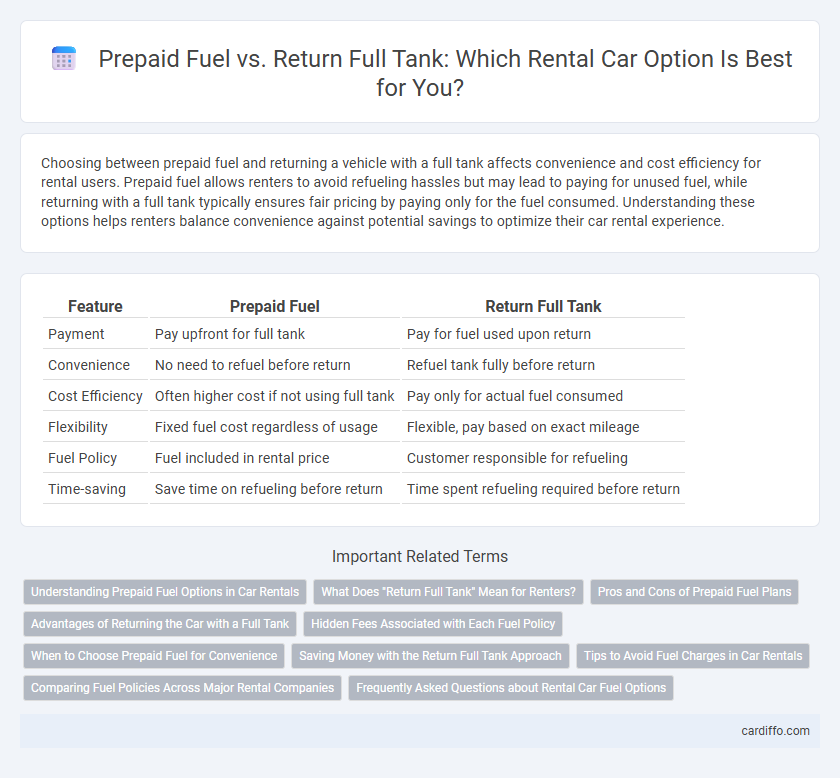Choosing between prepaid fuel and returning a vehicle with a full tank affects convenience and cost efficiency for rental users. Prepaid fuel allows renters to avoid refueling hassles but may lead to paying for unused fuel, while returning with a full tank typically ensures fair pricing by paying only for the fuel consumed. Understanding these options helps renters balance convenience against potential savings to optimize their car rental experience.
Table of Comparison
| Feature | Prepaid Fuel | Return Full Tank |
|---|---|---|
| Payment | Pay upfront for full tank | Pay for fuel used upon return |
| Convenience | No need to refuel before return | Refuel tank fully before return |
| Cost Efficiency | Often higher cost if not using full tank | Pay only for actual fuel consumed |
| Flexibility | Fixed fuel cost regardless of usage | Flexible, pay based on exact mileage |
| Fuel Policy | Fuel included in rental price | Customer responsible for refueling |
| Time-saving | Save time on refueling before return | Time spent refueling required before return |
Understanding Prepaid Fuel Options in Car Rentals
Prepaid fuel options in car rentals allow customers to pay upfront for a full tank of fuel, eliminating the need to refuel before returning the vehicle. This option provides convenience and can prevent extra charges for low fuel levels, though it may cost more than refueling independently. Understanding the terms of prepaid fuel plans, such as the price per gallon and refund policies on unused fuel, helps renters make cost-effective decisions.
What Does "Return Full Tank" Mean for Renters?
Return full tank" means renters must refill the fuel tank to the same level as at pickup before returning the vehicle, avoiding extra refueling charges. This policy ensures cost transparency since renters pay only for the fuel they use, making it a budget-friendly option compared to prepaid fuel plans. Failure to return the car with a full tank typically results in high refueling fees imposed by rental companies.
Pros and Cons of Prepaid Fuel Plans
Prepaid fuel plans offer the convenience of paying upfront, allowing renters to avoid refueling before returning the vehicle and potentially saving time at drop-off. However, these plans often come at a higher cost per liter, and unused fuel is typically non-refundable, leading to potential financial loss if the rental duration or mileage is underestimated. Renters seeking flexibility and cost efficiency usually prefer to return the car with a full tank, balancing fuel expenses with actual consumption.
Advantages of Returning the Car with a Full Tank
Returning the rental car with a full tank helps avoid high refueling charges that rental companies impose, often exceeding local fuel prices. This approach provides better control over fuel costs, as customers can purchase fuel at their preferred gas station rates before returning the vehicle. Ensuring the tank is full also streamlines the car return process, preventing disputes or delays related to fuel level discrepancies.
Hidden Fees Associated with Each Fuel Policy
Prepaid fuel options in car rentals often include hidden fees such as inflated refueling charges and non-refundable unused fuel, leading to higher overall costs. Returning a vehicle with a full tank avoids these fees but may result in penalty charges if not refueled correctly, including expensive fuel service fees per gallon. Understanding the rental company's fuel policy terms and monitoring fuel levels closely can prevent unexpected hidden fees and optimize rental expenses.
When to Choose Prepaid Fuel for Convenience
Prepaid fuel offers the convenience of avoiding refueling before returning a rental car, making it ideal for travelers with tight schedules or those unfamiliar with the local fuel stations. Choosing prepaid fuel can save time at drop-off and eliminate worries about fuel levels, especially when returning the vehicle outside regular business hours. It often suits short trips or urban rentals where finding a nearby gas station might be challenging.
Saving Money with the Return Full Tank Approach
Choosing the Return Full Tank option often saves money by allowing renters to refuel at local gas stations with competitive prices instead of paying the rental company's marked-up rates for prepaid fuel. This method eliminates hidden refueling fees and unnecessary premium charges commonly imposed when opting for prepaid fuel services. Renters benefit from the flexibility to purchase fuel as needed and only pay for what they actually use, maximizing overall cost efficiency.
Tips to Avoid Fuel Charges in Car Rentals
To avoid unexpected fuel charges in car rentals, choose a prepaid fuel option only if you are certain you will use the full tank, as unused fuel is often non-refundable. Opt for the return full tank policy when you can refuel the car yourself before returning it to save money on higher rental company fuel rates. Always keep receipts and refuel close to the rental return location to prevent extra fees and ensure transparency with the rental agency.
Comparing Fuel Policies Across Major Rental Companies
Major rental companies vary significantly in their prepaid fuel and return full tank policies, impacting overall rental costs and convenience. Prepaid fuel options, popular with companies like Hertz and Enterprise, allow renters to pay upfront at a fixed rate, avoiding refueling but often resulting in higher costs if the tank isn't fully used. Return full tank policies, favored by Avis and Budget, require customers to refill the tank before return, which can save money but demands time and effort to avoid refueling fees.
Frequently Asked Questions about Rental Car Fuel Options
Rental car fuel options often raise questions about prepaid fuel plans versus returning the vehicle with a full tank. Prepaid fuel allows renters to pay upfront for a full tank, avoiding refueling before return but may result in unused fuel cost. Returning the car with a full tank typically saves money for those who refuel close to the rental's specific fuel level, preventing extra fees charged by rental companies.
Prepaid Fuel vs Return Full Tank Infographic

 cardiffo.com
cardiffo.com